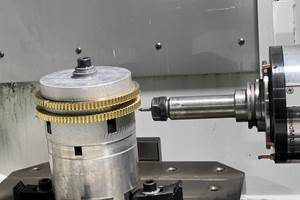Machine-Tending Robot Hits on Three Automation Trends
A new robotic loading system features a collaborative design, intuitive programming and the ability to be quickly redeployed to other turning centers.
Share




Current trends in machine-tending robot technology include collaborative robotics, in which a human can safely work near a robot without conventional fencing; easier deployment of robots to different machine tools when necessary; and simplified programming.
The Robo2Go machine-tending system from DMG MORI Systems leverages technologies that address each of these trends. It is particularly well-suited for shops that run a variety of different jobs, but would like to reap the benefits of unattended or lights-out machining on its DMG MORI turning centers that feature the company’s CELOS control.
Jeff Wallace, DMG MORI USA general manager—national engineering, says this system was developed for job shops that are new to robotic machine tending, which is why it was designed with an intuitive programming interface, meaning no dedicated robot programmer is required, and can be easily moved to and set up on various machines as necessary. (This is demonstrated in the video below.)
Hardware-wise, there are three primary system components: robot, part-loading module and safety scanning sensor. The six-axis robot is available in payload capacities of 22, 44 or 77 pounds (including workpiece and end-effector/grippers). Mr. Wallace says it can be delivered with end-effectors designed by DMG MORI, although some shops may choose to make their own end-effectors or have a third party produce them.
The robot accesses workpiece blanks from and delivers completed components to the system’s part-loading module. This module is topped with a tray that shops can machine from thin plate to best match the size, shape and number of blanks for a given job. The loading module features green and red indicators to serve as visual cues to show if all the parts in a given row is or isn’t completed. Mr. Wallace says it’s possible to program the robot to automatically flip the indicator once a row is completed.
To enable safe operation with humans working nearby, an infrared scanning sensor at the base of the unit is used to detect when someone approaches the robot. Users set up outer and inner safety zones for each machine the Robo2Go tends. Robot motion slows when someone enters the outer zone and resumes its normal speed when the person exits that zone. Robot motion stops when someone enters the inner zone closer to the robot, and resumes once an operator answers the prompt in the CELOS control to confirm that the work area is clear.
The Robo2Go can be moved from one machine to another using a fork truck. During setup, three template plates are positioned on the floor in front of the machine to initially locate the unit. The unit’s mounting pads are locked into position on those plates. An operator then “teaches” the robot so that its position relative to the machine is known. This is done by touching off a few machine datum points, such as the face of the spindle or chuck. The unit and machine communicate via the Profibus and Ethernet protocols.
Robot programming is performed at the machine’s tablet-like CELOS control using the Robo2Go app. The operator simply enters the dimensions of the workpiece, chuck and end effector, and then selects the proper workpiece tray configuration. Skeleton programs can also be created and saved to be quickly modified for new jobs.
Related Content
Cutting Part Programming Times Through AI
CAM Assist cuts repetition from part programming — early users say it cuts tribal knowledge and could be a useful tool for training new programmers.
Read MoreFour-Axis Horizontal Machining Doubles Shop’s Productivity
Horizontal four-axis machining enabled McKenzie CNC to cut operations and cycle times for its high-mix, high-repeat work — more than doubling its throughput.
Read More4 Steps to a Cobot Culture: How Thyssenkrupp Bilstein Has Answered Staffing Shortages With Economical Automation
Safe, economical automation using collaborative robots can transform a manufacturing facility and overcome staffing shortfalls, but it takes additional investment and a systemized approach to automation in order to realize this change.
Read MoreHow to Accelerate Robotic Deburring & Automated Material Removal
Pairing automation with air-driven motors that push cutting tool speeds up to 65,000 RPM with no duty cycle can dramatically improve throughput and improve finishing.
Read MoreRead Next
Registration Now Open for the Precision Machining Technology Show (PMTS) 2025
The precision machining industry’s premier event returns to Cleveland, OH, April 1-3.
Read MoreSetting Up the Building Blocks for a Digital Factory
Woodward Inc. spent over a year developing an API to connect machines to its digital factory. Caron Engineering’s MiConnect has cut most of this process while also granting the shop greater access to machine information.
Read MoreBuilding Out a Foundation for Student Machinists
Autodesk and Haas have teamed up to produce an introductory course for students that covers the basics of CAD, CAM and CNC while providing them with a portfolio part.
Read More





























